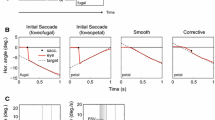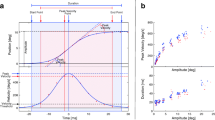Abstract.
The few studies on the development of oculomotor functions conducted so far suggest strong developmental effects of age on different parameters of saccade control in childhood and adolescence. The present study aimed at determining developmental functions for a set of 22 parameters derivable from the examination of pro- and antisaccades elicited under the 200-ms gap and overlap conditions (100 trials under each of the four conditions). The statistical analyses (including multiple regression, analysis of covariance, and principal components analysis (PCA) were based on a sample of 199 subjects aged 6–28 years, including 66% males and 34% females. We obtained the following main results: (1) In most cases, the variable "age–1" predicted the dependent variables much better than age. (2) Multiple regression approaches using Age and Age–1 as predictors accounted for 0–51% of the criterion variances, these values (adjusted R 2) being large for the proportion of direction errors during the antisaccade tasks (0.46–0.51), medium for anti- (0.36–0.46) and prosaccadic (0.23–0.34) reaction times (RT) and their standard deviations (0.26–0.45), and negligible for the proportion of express saccades. (3) The age variables (particularly Age–1), furthermore, predicted some of the effects of the experimental task manipulations on the different dependent variables (e.g. the augmentation of direction errors under the gap as compared to the overlap condition of the antisaccade task) significantly. (4) PCA results suggest 5 factors of saccade control in this sample: 2 factors comprising the antisaccade parameters, 2 factors comprising the prosaccade parameters, and 1 factor comprising the anticipations. The best correlations of the age variables with the corresponding factor scores were obtained for the 2 factors related to the antisaccade task parameters.
Similar content being viewed by others
Author information
Authors and Affiliations
Additional information
Electronic Publication
Rights and permissions
About this article
Cite this article
Klein, C. Developmental functions for saccadic eye movement parameters derived from pro- and antisaccade tasks. Exp Brain Res 139, 1–17 (2001). https://doi.org/10.1007/s002210100711
Received:
Accepted:
Issue Date:
DOI: https://doi.org/10.1007/s002210100711




